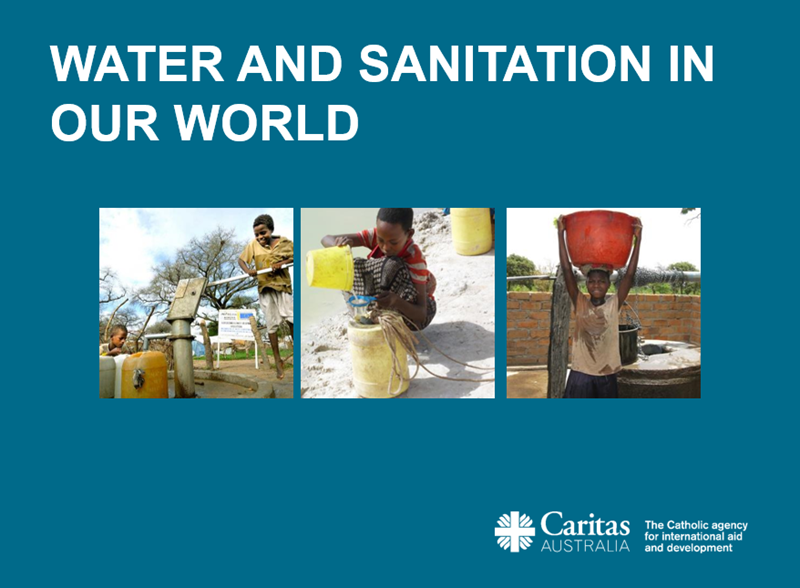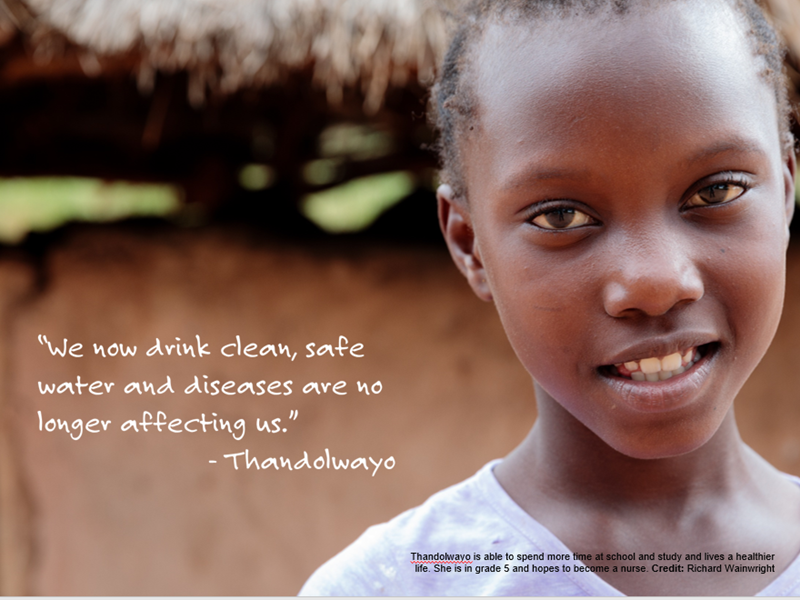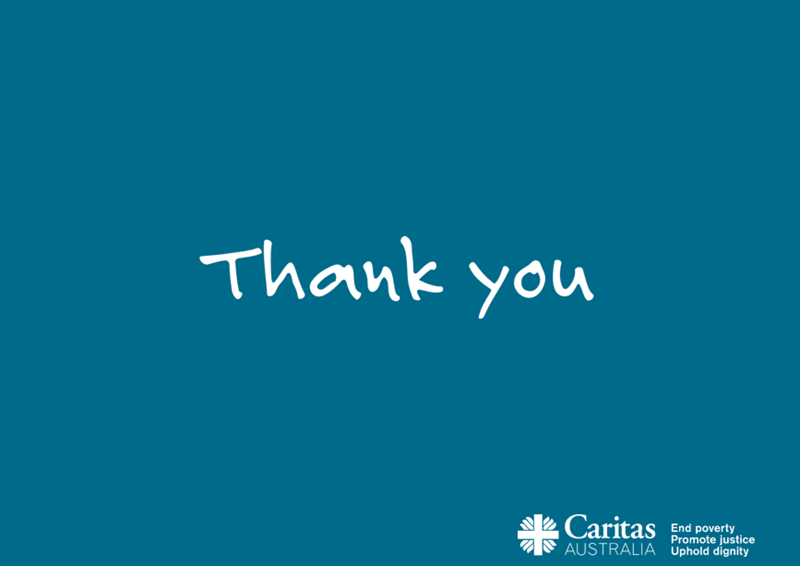
WATER AND SANITATION IN OUR WORLD
Information for teachers
How to use this resource:
This resource is intended as a source of information, case studies and task suggestions for teaching and learning about water and sanitation across several curriculum areas and units.
Please refer to the ‘Notes’ section of this presentation for additional information and source references.
It is our hope that you will take part/all of these slides and use them in a way that best suits your purposes. As such, the slides are editable so that the content, case studies and tools included in this resource are flexible for teachers and students to use in classroom instruction, independent student research or presentations. If you do edit this presentation, please ensure content and photos from this resources remain with the appropriate credit to Caritas Australia and the photographers.
CURRICULUM LINKS
- Year 7 | Geography | Unit 1: Water in the World
- Year 7 | Geography | Unit 2: Place and liveability | The influence of accessibility to services and facilities on the liveability of places (ACHASSK189)
- Year 10 | Geography | Unit 2: Geographies of human wellbeing| ACHGK076 – ACHGK081
- Year 10 | Civics and Citizenship | Government and democracy ACHCK091 | The Australian Government’s role and responsibilities at a global level, for example provision of foreign aid, peacekeeping, participation in international organisations and the United Nations
The gift of WATER
- How many times do you access water in one day?
- How do you access it?
- What would your life be like without taps?
It can be easy to forget how important water is. Across most of Australia, at the turn of a tap we have instant access to clean drinkable water.
663 million people around the world do not have access to clean water.
THE DIGNITY OF SANITATION FACILITIES
- Think of your school or home sanitation facilities, are they safe and private?
- What would your life be like without a toilet?
It is easy to forget how important access to sanitation facilities is. Across most of Australia we have access to safe, clean and private facilities.
2.3 billion people lack access to basic sanitation such as a toilet or latrine.
THE GIFT OF WATER
Water is essential to life. Sourcing it and collecting it is not an option.
Water means food security. Water means health. Water means safety and security. Access to water and sanitation is necessary to develop other areas of a healthy life.
Yet structural and economic injustice has resulted in unequal access to a God given resource.
Over the past century, unclean water, poor sanitation and unsafe hygiene practices have claimed more lives than anything else.
Safe sanitation impacts all areas of life
IMPROVING HEALTH
1,000 children die each day due to preventable water and sanitation related diarrhoeal diseases which could be prevented by improved Water, Sanitation and Health (WASH).
BETTER EDUCATION
443 million sick days are taken by children every year due to WASH related diseases.
1 in 3 schools lack access to water and basic sanitation.
NUTRITION
In 2017, 151 million children worldwide under age 5 suffered from stunting. One of the main cause is WASH-related diseases like diarrhea that prevent the proper absorption of nutrients from food.
REDUCING INEQUALITY
4 billion people lack access to basic sanitation services, such as toilets or latrines.
GENDER INEQUALITY
- In many countries around the world, women are responsible for finding and collecting water for their families. This can be a dangerous chore. Collecting water from sources like rivers can include risk of attack from animals such as crocodiles.
- Women and girls can face disease, harassment, shame and the threat of violence because they have no safe sanitation choices.
- Many girls don’t attend school if there are no safe and private toilets available for menstrual hygiene management.
Progress since the millennium development goals (MDG) 2000-2015
Goal 7 of the MDGs was to ensure environmental sustainability, including halving the proportion of people without access to safe water and sanitation between 2000-2015. Global action has led to positive results.
In 1990 MDG GOAL
76% of the global population used improved water sources 88%
54% of the global population used improved sanitation facilities. 77%
Progress since the millennium development goals
WATER GOAL MET IN 2010
91% of the world’s population now access improved sources of drinking water.
X 8 /10 people in the world who live in rural areas are still without a source of improved drinking water
X 663 million people still lack access to improved drinking water sources.
SANITATION GOAL MISSED
X Only 68% of the global population now uses improved sanitation facilities (Goal was 77%)
ü2.1 billion people have gained access to improved sanitation since 1990
X 2.4 billion people still lack improved sanitation facilities.
EXPLORE GLOBAL SANITATION PROGRESS
Use this interactive tool from the World Health Organisation to analyze progress on water and sanitation for different countries between 1990-2015.
Interactive Progress on Sanitation and Drinking Water 2015 Dashboard
SUSTAINABLE DEVELOPMENT GOALS
In 2015, the new Sustainable Development Goals (SDGs) were released.
These are 17 goals for everyone, everywhere, aimed at achieving three extraordinary things in the next 15 years:
- End extreme poverty.
- Fight inequality & injustice.
- Fix climate change.
WATER: THE WELL OF HOPE
In 2014-15, Caritas Australia worked with local communities to provide better access to safe and sustainable water.
- More than 175,000 people gained improved access to safe water globally.
- The Caritas network reached more than 260,000 people with tarps, mats, blankets, food, and kits for water, sanitation and hygiene in Nepal.
- 78,775 people have increased access to safe water in Malawi and Tanzania.
Thandolwayo, zimbabwe
Thandolwayo would then go to school feeling exhausted. Her hope to be a nurse seemed almost impossible to realise, until Caritas Hwange helped the village to install two solar powered pumps and two 10,000 litre water storage tanks. The pumps draw the water up from the river to the storage tanks.
Thandolwayo, zimbabwe
Thandolwayo can also concentrate on her education. Water is also being used to mould bricks, with plans for a community garden and fish pond to generate better income.
“Hope is important because it makes me work harder,” Thandolwayo says.

WATER: THE WELL OF HOPE
Caritas Australia’s mission is to work towards a world that God desires to be just and compassionate.
Together our WASH programs contribute to improving the health of communities through promoting the growth of nutrition crops and through reducing illnesses. With your support, these initiatives also provide marginalised communities with a greater sense of empowerment, and hope for the future.
This is something to rejoice in.
You can raise awareness and funds to improve access to water and sanitation by hosting a Caritas K’s Walk for Water. Click here to find out more!

CARITAS AUSTRALIA EDUCATION RESOURCES
This resources was last updated February 2019.
For more resources please visit https://www.caritas.org.au/resources/school-resources/
We would love to hear from you! To send feedback, enquiries or comments, please email us as education@caritas.org.au
Stay up to date with events and resources!
Subscribe to your state’s term newsletter by emailing your name to education@caritas.org.au